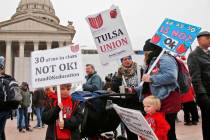Legendary explorer John C. Fremont put Las Vegas on the map
Every schoolchild in Las Vegas is taught about John C. Fremont and where the names Las Vegas and Nevada come from, and Michael Green should know. He wrote the eighth-grade textbook used by most of the valley schools, "Nevada: A Journey of Discovery." He also covered the subject in a book he co-authored with Eugene P. Moehring, "Las Vegas: A Centennial History."
"In both cases we don't know who originally named them," Green said. "But we know who first literally put the names on the map."
Nevada is the Spanish word for "snow-covered," and the mountains that run near the border of California and Nevada have been called the Sierra Nevada for more than two centuries.
"Nevada first showed up on a map drawn in 1776 by a Spanish priest named Father Pedro Font," Green said. "In 1857, settlers in the Carson Valley and Dayton area, who wanted to be a separate territory from Utah, proposed the name 'Sierra Nevada Territory,' but someone shortened it to just Nevada Territory, and that's what we went to statehood with."
The Spanish had been traveling through what is now Southern Nevada on a difficult trade route linking what is now northern New Mexico to Los Angeles. Initially travelers took a route that went south of the Las Vegas Valley, but the route had shifted by the time Fremont came through the area.
Fremont was on his second mapping expedition of the lands between the Rockies and the Pacific Ocean in 1843 and '44. In January 1844, heavy snow in Northern Nevada forced the expedition to abandon equipment as the group traveled south, hoping to connect with the Spanish Trail and head east to Santa Fe, N.M.
While following the Mojave River, the group encountered two survivors from an Indian attack . The Mojave is an intermittent river and wash that follows within a few miles of Interstate 15 in California and crosses it at Barstow and Victorville. The pair led Fremont's group along the Spanish Trail on a four-day trip to where the attack had happened, near the Tecopa Hot Springs southwest of Pahrump. They discovered that two of the party had been killed and the other two, the women, presumably had been taken.
From there, the party continued northeast, arriving in the Las Vegas Valley on May 3.
"We encamped in the midst of another large basin, at a camping ground called Las Vegas - a term which the Spanish use to signify fertile or marshy plains," Fremont wrote in his diary.
Most sources simplify the translation of Las Vegas to "The Meadows," but the word is more specific than the more common Spanish word for meadows, "prados." "Vega" usually refers to low-lying fertile ground, often along a river.
Fremont described two streams of clear, fast running water that was 4 or 5 feet deep emanating from two springs. They measured the water as being 71 degrees in one stream and 72 in another. "Too warm to be agreeable," Fremont wrote, but they did find it good for bathing.
When Fremont returned to Washington, D.C., he listed the Old Spanish Trail on his map and marked Las Vegas on a map for the first time.
Congress had 20,000 copies of the maps and colorful accounts of the expedition's travels printed, and it became an essential piece of equipment for anyone traveling west as Las Vegas became an established landmark.
"When the Mormons came to the valley in 1855, they called it the Las Vegas Mission," said Mark Hall-Patton, curator of Clark County museums. "The post office was called the Bringhurst Post Office after William Bringhurst, the fellow that ran the mission, but that was never in the running for the name of the town."
After creating the definitive map of the West in his time, Fremont went on to be instrumental in inciting the Bear Flag Revolt in California in 1846, which led to the war with Mexico and the United States' acquisition of California. He served as governor of California during the conflict and was later governor of Arizona, a Union general and the first Republican candidate for U.S. president.
Fremont is the namesake of Fremont Street, and by extension the Fremont Street Experience, the Fremont Hotel & Casino and other businesses on the street.
Fremont died in 1890 on a trip to New York from his home in California. His wife, Jesse Benton Fremont, said of him, "From the ashes of his campfires have sprung cities."
Contact Sunrise/Whitney View reporter F. Andrew Taylor at ataylor@viewnews.com or 380-4532.














